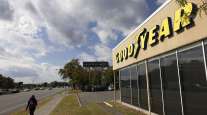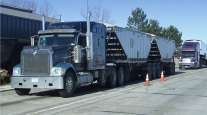Big Three Continue to Dominate U.S. Tire Market
This story appears in the May 3 print edition of Transport Topics.
There was a time when foreign-based tire manufacturers had to overcome major hurdles to enter the North American market.
Guy Walenga, director of engineering, commercial products and technologies for Japanese-owned Bridgestone Americas, remembers how lingering resentment over World War II created business barriers.
“I know from firsthand experience how difficult it was in some cases to get someone to buy a Bridgestone product in west Texas 25 years ago,” Walenga said. “I was there and I was doing it, and someone who had a bad memory because of the war just wouldn’t do it.”
Though purchasing decisions today are not made based on long-ago conflicts, tire makers associated with their foreign roots said they still face an uphill battle to gain a larger portion of the market as many U.S. fleets stick with the big three — Goodyear Tire & Rubber Co., Bridgestone and Michelin North America.
Figures released in June by the Rubber Manufacturers Association show the extent to which the manufacturers continue to dominate the commercial truck tire market.
Bridgestone maintains 25.5% of the market for commercial truck tires, according to RMA, while Goodyear comes in at 24% and Michelin owns 22%.
Bridgestone Americas is a subsidiary of Bridgestone Corp., based in Tokyo. Goodyear Tire and Rubber Co. is based in Akron, Ohio, while Michelin has headquarters in France. All three companies have a presence throughout much of the world.
In the United States, no other tire maker can claim as much as a 7% market share.
As a result, the smaller, foreign tire makers, based in countries including Germany, Japan and South Korea, must place a priority on service reach if they want to gain customers, said Aaron Murphy, vice president of the China Manufacturers Alliance LLC, which owns Double Coin.
The company has increased its sales presence at truck stops, which he said is helping it to ramp up its overall number of points of sale.
“All the smaller foreign manufacturers are trying to build up their service network,” Murphy said. “Double Coin now has almost 1,000 points of sale in North America. If you look at the big three, they may have 3,000 or 4,000 points of sale. So we’re not there yet.”
Murphy noted that Double Coin has made noticeable gains with smaller fleets.
“We’ve found ourselves very strong with owner-operators and construction fleets, which tend to be regional,” Murphy said.
For Yokohama, a series of relationships with independent dealers fits its business model more than building up its own network, said Rick Phillips, manager of commercial sales for Yokohama Tire Corp., San Antonio, Texas.
“We chose not to bring a re-tread process to market that would compete with our dealers,” he said. “We chose not to own our distribution. We just want to stick with what we do best, which is to manufacture world-class products that are environmentally friendly and provide solutions to the transportation industry.”
Because the larger manufacturers have gained such a foothold among equipment manufacturers and fleets, smaller, foreign competitors said some of the resistance appears to be a reluctance to change.
Don Pabst, vice president of equipment services for less-than-truckload firm YRC Worldwide Inc., said his company prefers to let other fleets gain experience with newer suppliers — regardless of where they are based — and then considers using them if they prove their value.
Others fleet executives agreed.
“The simple answer is this,” said Steven Graham, vice president of purchasing for truckload carrier Schneider National Inc. “The three major manufacturers here — Goodyear, Michelin and Bridgestone — have been operating in the U.S. for years and have put in place the infrastructure, the people and facilities, to support new equipment and replacement tire needs, and to solve the trucking companies’ operating challenges and opportunities.”
Murphy acknowledged that foreign manufacturers have to compete for what’s left of the market, while they ramp up their capabilities to compete with the larger tire makers.
“Double Coin is trying to go after the same sale” that other foreign-based competitors are, while trying to entice the largest fleets, Murphy said. “That comes with performance, service, brand recognition and a lot of different factors. It’s a long process.”
The process does not include arguing that foreign-made products are cheaper.
“When you look at the cost of labor and the manufacturing of a tire, it’s a very small portion,” Murphy said. “People think, ‘Well, you make a tire in China, and it’s cheap because it costs nothing to make.’ Well, the raw materials and the process and the freight still cost as much as anywhere else in the world.”
Manufacturers that operate plants overseas are not doing so primarily because of the cost of labor, Phillips said, but because of issues such as market proximity and distribution strategies.
“For anything you save in labor, you’ve got the cost of transporting the tires to the U.S., so it’s pretty much a wash,” Phillips said. “It’s not really a big savings for us. Our strategy is not to build a plant overseas because it’s cheaper. We have plants in Japan and Thailand because, strategically, it fits for us.”
At the same time, foreign firms are looking to expand their manufacturing operations in the United States wherever it makes sense.
Julie Sediq, a spokeswoman for Kuwana, Japan-based Toyo Tire & Rubber Co. Ltd., said Toyo will invest about $300 million in its plant in White, Ga., this year to increase production capacity and add jobs.
Regardless of where the tires are made, the lesser-known foreign manufacturers said they still find themselves answering a common question: Can their products be as good?
Marc Laferriere, vice president of marketing for Michelin Americas Truck Tires, Greenville, S.C., said he believes foreign competitors have a lot to overcome.
“What should fleets be looking for when looking for a supplier?” Laferriere asked rhetorically. “How long have they been around in terms of the market, and how much are they willing to protect their brand equity? Am I going to take a chance on somebody that doesn’t have as much to lose if they compromise their brand equity?”
Laferriere said fleets and manufacturers tend to prefer the comfort level dealing with a supplier they’ve already worked with extensively, because they don’t have to wonder about those issues.
Murphy agrees this challenge remains.
“It’s something you have to address every time you’re dealing with someone who doesn’t know anything about your company, who doesn’t know your product or doesn’t have a history with it,” he said. “I looked at that great American company that we all buy from, Wal-Mart, and the majority of their product comes from China.”
Still, Murphy believes Bridgestone’s success over the past decades proves that barrier can be overcome.
“My father and my grandfather wouldn’t even consider buying a Bridgestone tire because of what happened in World War II, but today Bridgestone has the largest market share,” Murphy said. “Things have changed.”
While history shows that foreign manufacturers can make big strides, the players in the current market are realistic about where they stand.
“There are the big three, and there’s the rest of the market, and everyone else is kind of following the big three,” Phillips said. “They’re in kind of a Tier 1. We don’t have any grand illusions that we’re in Tier 1. We know we’re a Tier 2 company, but we place ourselves at the top of the second tier.”
Bridgestone’s Walenga said he believes the second-tier foreign manufacturers can gain market share in the same way his company did in previous years.
“I don’t think it’s impossible for the other companies to get bigger,” Walenga said. “The market’s expanding, and 100% today isn’t what 100% was yesterday. You don’t always have to steal someone’s market share.”




